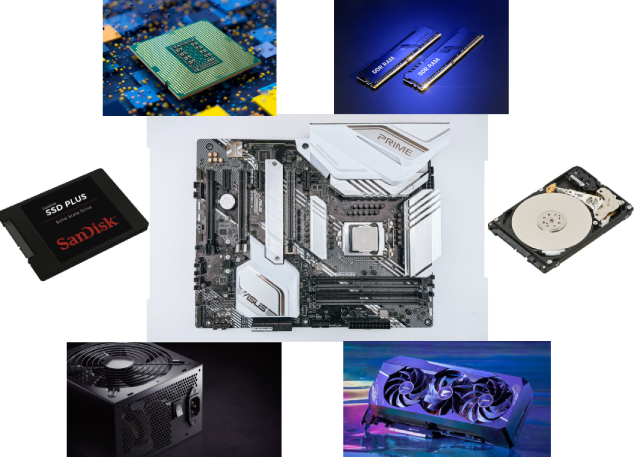Basics of Computer Technology and Networking
Basics of Computer Technology and Networking
Contents
Computer Hardware
There are several different kinds of hardware inside a PC.

Motherboard: The motherboard is like the skeleton of a computer. The motherboard connects all the other hardware together.
CPU (Central Processing Unit): The CPU is like a brain. Human has a speed of thinking and the same thing is valid for CPU and it’s measured in GHz(Gigahertz).
RAM (Random Access Memory): RAM is like a temporary CPU. RAM temporarily stores information and the stored data is erased each time. RAM has many important functions, including rendering images for graphic design, editing video or photos, and multitasking with multiple applications or programs open. How much RAM you need depends on the programs you’re running. It will change with new technologies. Today, 8GB of RAM is nothing. You need more than that.
HDD (Hard Disk Drive) and SSD (Solid State Drive): HDD and SSD are two different types of storage. HDDs are older technology and slower than SSDs. SSDs come out as the clear winner, primarily based on speed, durability, and power consumption.
GPU (Graphics Processing Unit): GPUs process graphical data. A dedicated graphics card connects with the motherboard via an expansion slot, so you can upgrade your graphics card if you want to improve gaming, video, or visual performance from your PC. And some PC’s. Have different versions of CPUs and at that time CPUs does process graphical data.
PSU (Power Supply Unit): A PSU takes electricity from an external power source or laptop battery and passes it to the motherboard to power individual hardware components. This makes it essential to use a power supply with suitable wattage.
Connection Types
Ethernet: Ethernet is wired networking technology that allows devices to communicate within a Local Area Network (LAN). It was first developed in the 1970s by Xerox, Intel, and Digital Equipment Corporation (DEC). Ethernet’s biggest advantages are high speed, reliability, and security. Unlike wireless connections, it experiences less interference and fewer disruptions. The physical cabling also enhances security by preventing unauthorized access. However, its wired nature does come with some downsides, such as limited mobility and higher installation costs.
Wi-Fi (Wireless Fidelity): Wi-Fi, works by transmitting data over radio waves. Instead of using physical cables like Ethernet, Wi-Fi enables devices to send and receive information through the air. This is made possible by a router, which connects to the internet via a wired connection and then broadcasts a wireless signal that your devices can pick up.
Bluetooth: Bluetooth is a wireless communication standard that enables data exchange over short distances. Operating on the 2.4 GHz ISM (Industrial, Scientific, and Medical Devices) band, it allows devices to communicate directly with each other.
The advantages of Bluetooth include low power consumption, cost-effectiveness, and universal compatibility. However, due to its limited data transfer speed and range, it may not be suitable for applications requiring high bandwidth or long-distance connectivity.
Fiber-Optic Connections: Fiber-optic connections use light signals through glass or plastic fibers to transmit data at very high speeds over long distances, making them ideal for internet backbones or connecting data centers. Fiber is faster and more reliable than traditional copper cables, but it is also more expensive to implement.
Cellular Connections: Cellular connections are a type of wireless communication technology that enables devices to connect to a mobile network for voice calls, messaging, and internet access. These networks operate through a system of cell towers that transmit signals over radio frequencies, allowing seamless connectivity even while moving between locations.
Cellular technology has evolved through multiple generations, from 1G (analog) to modern 5G, which offers ultra-fast speeds and low latency. The main advantages of cellular connections include wide coverage, mobility, and reliable internet access. However, factors like network congestion, signal interference, and data plan costs can affect performance.
NFC (Near Field Communication): Cellular connections are a type of wireless communication technology that enables devices to connect to a mobile network for voice calls, messaging, and internet access. These networks operate through a system of cell towers that transmit signals over radio frequencies, allowing seamless connectivity even while moving between locations.
Cellular technology has evolved through multiple generations, from 1G (analog) to modern 5G, which offers ultra-fast speeds and low latency. The main advantages of cellular connections include wide coverage, mobility, and reliable internet access. However, factors like network congestion, signal interference, and data plan costs can affect performance.
(IR) Infrared:) IR is a wireless communication technology that uses infrared light to transmit data over short distances. It operates on the electromagnetic spectrum just beyond visible light and is commonly used in remote controls, short-range data transfer, and some sensing applications.
![]()
![]() I hope you learned something and had fun. But that’s it for now till next time take care.
I hope you learned something and had fun. But that’s it for now till next time take care. ![]()